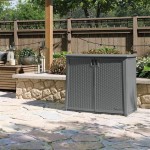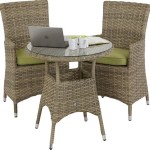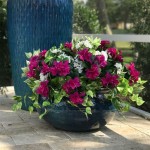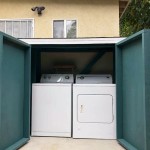Outdoor Wall Hanging Flower Pots: A Comprehensive Guide
Outdoor wall hanging flower pots present a versatile and aesthetically pleasing solution for adding greenery and floral displays to various exterior spaces. These planters offer a compelling alternative to traditional ground-based gardening, particularly in areas with limited space or where enhanced visual appeal is desired. This article provides a detailed examination of outdoor wall hanging flower pots, encompassing their benefits, types, material options, installation considerations, plant selection, and maintenance requirements.
Space Optimization and Aesthetic Enhancement
One of the primary advantages of outdoor wall hanging flower pots is their capacity to maximize space utilization. In urban environments, balconies, patios, and small gardens often possess restricted surface area. Wall-mounted planters effectively exploit vertical spaces, transforming otherwise unused walls into vibrant displays of foliage and blooms. This vertical gardening approach is particularly beneficial for individuals residing in apartments or condominiums where ground-level gardening is not feasible.
Furthermore, wall hanging flower pots significantly contribute to aesthetic enhancement. They can soften the appearance of bare walls, create focal points, and introduce color and texture to outdoor environments. By strategically positioning these planters, individuals can define outdoor spaces, create visual interest, and establish a welcoming atmosphere. The diverse range of styles and materials available allows for seamless integration with various architectural designs and personal preferences.
Outdoor wall hanging flower pots also offer a unique perspective on plant display. Elevated blooms and foliage are brought closer to eye level, allowing for a more intimate appreciation of their beauty and fragrance. This proximity enhances the sensory experience of gardening and provides a distinctive way to showcase prized plants.
Types of Outdoor Wall Hanging Flower Pots
The market provides a wide array of outdoor wall hanging flower pots, each catering to specific needs and aesthetic preferences. Understanding the different types available is crucial for selecting the most suitable option for a given application.
Basket Liners: These are typically made of coco coir, moss, or other natural fibers and are designed to fit inside wire baskets. They offer excellent drainage and aeration, promoting healthy root development. Basket liners are a popular choice for creating cascading displays of flowering plants.
Self-Watering Wall Planters: These planters incorporate a reservoir that gradually releases water to the plants, reducing the frequency of watering. This feature is particularly beneficial for busy individuals or those living in hot, dry climates. Self-watering planters often include a water level indicator to ensure optimal moisture levels.
Rail Planters: Designed to hang over railings of balconies, decks, or fences, rail planters are ideal for adding greenery to elevated spaces. They are typically made of durable materials such as metal, plastic, or wood and come in various sizes and styles.
Pocket Planters: These planters feature multiple pockets or pouches for planting individual plants. They are often used to create vertical gardens or living walls, showcasing a variety of different species in a compact space. Pocket planters are typically made of felt or other porous materials that allow for proper drainage and aeration.
Ceramic Wall Pots: Offering a touch of elegance and sophistication, ceramic wall pots are available in a wide range of colors, shapes, and sizes. They are typically glazed to protect them from the elements and to enhance their aesthetic appeal. Ceramic pots can be heavier than other types of wall planters, so it is important to ensure that the mounting hardware is sufficiently strong.
Plastic Wall Pots: Plastic wall pots are a lightweight and cost-effective option for outdoor gardening. They are available in a variety of colors and styles and are often resistant to fading and cracking. Plastic pots are a good choice for individuals seeking a durable and low-maintenance option.
Material Considerations and Durability
The material composition of outdoor wall hanging flower pots significantly impacts their durability, aesthetics, and suitability for specific climates. Choosing the right material is essential for ensuring the longevity and performance of the planters.
Terracotta: Terracotta is a classic material known for its porous nature, which allows for excellent drainage and aeration. However, terracotta is susceptible to cracking in freezing temperatures and may require special care in colder climates. Terracotta pots also tend to dry out more quickly than other types of planters, requiring more frequent watering.
Plastic: Plastic planters are lightweight, durable, and relatively inexpensive. They are resistant to fading, cracking, and freezing, making them a suitable option for a wide range of climates. However, some plastic planters may not be as aesthetically pleasing as other types of planters. The choice of plastic material also influences the longevity of the products. UV-resistant plastics will resist fading and cracking under direct sunlight. Recycled plastics promote sustainability.
Metal: Metal planters offer a modern and industrial aesthetic. They are typically durable and weather-resistant, making them a long-lasting option for outdoor use. However, metal planters can become hot in direct sunlight, which can be detrimental to plant roots. It is important to choose a metal planter with a light-colored finish or to provide shade to protect the plants from excessive heat. Galvanized steel and powder-coated aluminum are common choices that offer rust resistance.
Wood: Wooden planters offer a natural and rustic aesthetic. They are typically made of cedar, redwood, or other weather-resistant woods. Wood planters can provide good insulation for plant roots, protecting them from temperature extremes. However, wood planters require regular maintenance to prevent rot and decay. Applying a sealant or stain can help to prolong the lifespan of the wood.
Resin: Resin planters are a durable and lightweight alternative to traditional materials. They are resistant to fading, cracking, and freezing, making them a suitable option for a wide range of climates. Resin planters are also available in a variety of styles and finishes, mimicking the appearance of terracotta, stone, or metal.
Installation and Weight Considerations
Proper installation is crucial for ensuring the safety and stability of outdoor wall hanging flower pots. It is essential to select appropriate mounting hardware and to consider the weight of the planter when filled with soil and plants.
The weight of the filled planter must be carefully considered, as it will exert significant force on the mounting surface. For lighter planters, standard wall anchors or screws may suffice. However, for heavier planters, it is essential to use heavy-duty anchors or to mount the planter directly to a structural element of the wall, such as a stud or beam. Incorrect installation can lead to the planter falling, potentially causing injury or damage. Consult with a professional if you are unsure about the appropriate installation method.
The type of wall surface will also influence the choice of mounting hardware. Different types of anchors are required for concrete, brick, stucco, and siding. Ensure that the chosen anchors are compatible with the wall material and are rated for the weight of the filled planter.
Consider the accessibility of the planter for watering and maintenance. Installing the planter at a comfortable height will make it easier to care for the plants. If the planter is installed in a difficult-to-reach location, consider using a self-watering planter or installing an irrigation system.
Proper drainage is essential to prevent water damage to the wall. Ensure that the planter has drainage holes to allow excess water to escape. Consider using a saucer or drip tray to catch any water that may drain from the planter.
Plant Selection and Growing Conditions
The selection of plants for outdoor wall hanging flower pots should be based on several factors, including the amount of sunlight the wall receives, the climate, and the desired aesthetic. Choosing plants that are well-suited to the growing conditions will ensure their health and vitality.
Sunlight: Assess the amount of sunlight that the wall receives throughout the day. Some plants require full sun (6 or more hours of direct sunlight per day), while others prefer partial shade (4-6 hours of direct sunlight) or full shade (less than 4 hours of direct sunlight). Choose plants that are appropriate for the amount of sunlight available. Also, consider the direction in which the wall faces. South-facing walls tend to be the warmest and sunniest, while north-facing walls tend to be the coolest and shadiest.
Climate: Consider the climate in your region, including temperature extremes, humidity levels, and precipitation patterns. Choose plants that are hardy in your climate zone and that can tolerate the local weather conditions. For example, in hot, dry climates, choose drought-tolerant plants such as succulents or cacti. In colder climates, choose plants that are hardy to freezing temperatures.
Soil: Use a high-quality potting mix that is well-draining and provides adequate nutrients for the plants. Avoid using garden soil, which can be too heavy and may not drain properly. Consider adding slow-release fertilizer to the potting mix to provide a steady supply of nutrients to the plants.
Watering: Water the plants regularly, especially during hot, dry weather. Check the soil moisture regularly by sticking your finger into the soil. If the soil is dry to the touch, it is time to water. Avoid overwatering, which can lead to root rot. Consider using a self-watering planter or installing an irrigation system to ensure that the plants receive adequate moisture.
Maintenance: Regularly prune and deadhead the plants to encourage new growth and to keep them looking their best. Remove any dead or diseased foliage. Fertilize the plants regularly to provide them with the nutrients they need to thrive. Monitor the plants for pests and diseases and take appropriate action if necessary.
Aesthetic Considerations: The aesthetic outcome of outdoor wall hanging flower pots is dependent on the specific plant combinations. Choose plants with a variety of textures, colors, and heights to create visual interest. Consider the overall style of the wall and the surrounding landscape when selecting plants. Trailing plants, such as petunias or ivy geraniums, can create a cascading effect, while upright plants, such as geraniums or salvia, can add height and structure.

Travelwant Wall Hanging Planters Planter Flower Pots For Indoor Outdoor Railing Fence Balcony Window Garden

Grayson Lane 2 Pack Rectangle 10 45 In W Large White Metal Indoor Outdoor Wall Planter 43748 At Lowes Com

Agfabric Light Green Iron Flower Pots Garden Balcony Hanging Planter Bucket Holders 1 Pack

Spring Park Wall Hanging Flower Pots Garden Fence Balcony Basket Plant Pot Planter Decor

Metal Wagon Wheel Planter Hanging Pots Fence Patio Outdoor Garden Wall Art Decor Ebay

Wall Hanging Flower Pots Garden Fence Balcony Basket Plant Pot Planter Decor Ebay

Ceramic Indoor Outdoor Wallscape Planter Small 4 3 D X H White West Elm

Dhgate Com Ceramic Hanging Planters Set Of 4 Wall Mounted Flower Pots For Indoor Outdoor Home Garden Decor

Triangular Metal Wall Planter Large Mounted Outdoor Handmade Pots Unique Etsy

Set Of 2 Dual Wall Hanging Iron Basket Planters Copenhagen 1843 In Cobalt Blue








